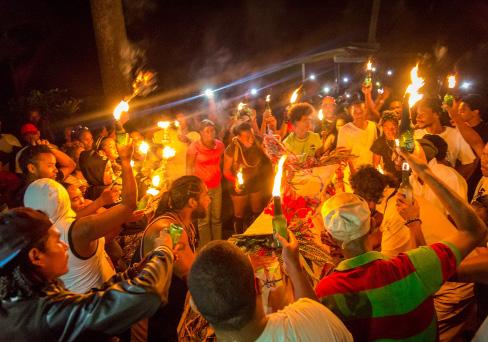
5 minute read
Tewe Vaval
by: Prosper Paris
Vaval is a symbol ceremony which happens on Ash Wednesday in which people symbolically bury the Spirit of Vaval (Carnival). All the festive activities of Monday and Tuesday of Carnival are over and people get together hold a mock burial of Vaval, symbolically burying the spirit of Vaval. This takes the form of a coffin, in which dummy is placed and people dress in typical funeral outfits of white and black and carry flowers. A wooden cross decorated with flowers is also made. The Vaval ceremony usually starts at 3:00 p.m. on Ash Wednesday in the Kalinago Territory, especially in Bataca. People go up and down the Territory covering a five miles radius until about 7:30 – 8:00 p.m. when a bonfire is lit. The coffin is placed on the bonfire and the drummers play. People dance round the fire and sing vaval vaval nou ka alé téwé vaval. It is very sad because the carnival festivities have ended and people go into tears. The costumes, the tèt mas, which were used during carnival are put over the fire and burnt. People go around the fire until everything is burnt out. It is all over till the following year when the ceremony of ‘Lévé Vaval’ takes place.
Advertisement
Vaval itself was not a part of the Kalinago heritage until the 1980s. The reason for this is that after Hurricane David in 1979 a number of young people went over to Guadeloupe and Martinique where Vaval was celebrated and when they returned, they introduced it to the Kalinago Territory. At first Vaval was done in St Cyr, Bataca and Sineku to a lesser extent.
Vaval was something that was illegal. As far as carnival laws were concerned, when it is 10 o’clock on Carnival Tuesday night everything is over, drums should be put aside. At the beginning, Vaval received a lot of opposition from the religious people especially the Catholics of the community. Kalinago people are typically Catholic.
In the early years of Vaval, rebel guys would gather in the afternoon and start drumming. This was not done on the public road. There was a group called Chien Zonbi led by Earl Dorsette which was very active in the 80s. Newton Tyson, who brought up the idea of Vaval, was also part of that. They would beat the drums at the Chien Zonbi area and then would go up the village road in Bataca, if they were not intercepted by police. The police at the Police Station in Salybia would hear the drums in Bataca and would come to stop it and disperse the crowd.
The Kalinago people struggled with this for a number of years until 1993 when for the first time a huge Kalinago contingent participated in the carnival in Roseau. It was the occasion of the five hundred years after discovery. There was a big float organized by an organization in the Territory led by Roy Tyson. In 1993 therefore, that is when Vaval made its big entrance on the public roads. So many people turned out for the activity that if the police had to arrest anyone, they would have to arrest thousands of people. The police were there observing anyway. There was a ceremony. Someone was dressed as a priest. This again received opposition from the Catholic sector. This was one of the best years of Vaval. There were thousands of people and not many strangers. It was Kalinago people themselves; people dressed in black and white with their flowers and singing throughout the Vaval area. So from that year on, Vaval has been a yearly activity on Ash Wednesday and it started drawing thousands of people to the Kalinago Territory; some coming to observe, some coming to participate, some curious and even while saying it is not good, came to see it anyway. There was a lot of commercial activity - people setting up bars.
By 2010 the Kalinago Events Committee came on board and started organizing Vaval formally. The Dominica Festivals Commission began providing support and now sponsors part of Vaval. Vaval became part of agenda of the carnival festivities in Dominica. On the line-up of festivities there is Téwé Vaval on Ash Wednesday. It is a national celebration now where people come to the Territory to observe what Vaval is like.
Over the years it has grown; there are lots of visitors. By 2018, white and black outfits were not very visible among locals but torches have been introduced. This is very spectacular, especially at about 7:30 pm - 8:00 pm
when torches are lit - about fifty to a hundred bouzay (torches) in all – while the final ceremony is being held. Apart from this, there is a formal closing ceremony where the Events Committee issues prizes to the best deserving bands on the road, best darkie and best mas. From 2018, the After Vaval party has been held, in which other bands and artists have been invited to close up Vaval. This has added another element to the Vaval celebrations and has even made it more attractive for visiting.
Apart from the festive component of Vaval, there are other things happening. In 2019, the organizers started introducing traditional food and drinks; Kalinago cuisine to the patrons so they can have a wonderful time in the Territory. Vaval now serves both as a ceremonial activity and an economic activity for Kalinago residents.

Looking forward, Vaval will have to take a turn. While Vaval is on the carnival events calendar as an activity, it is not legal as a holiday event. The ceremony may have to be moved from the public road to a playing field or an enclosed area because there is a problem with traffic. The main road has to be blocked from 5:00 pm for about three hours. Vaval will become a major commercial activity requiring more space, more seating and more activities for patrons.















